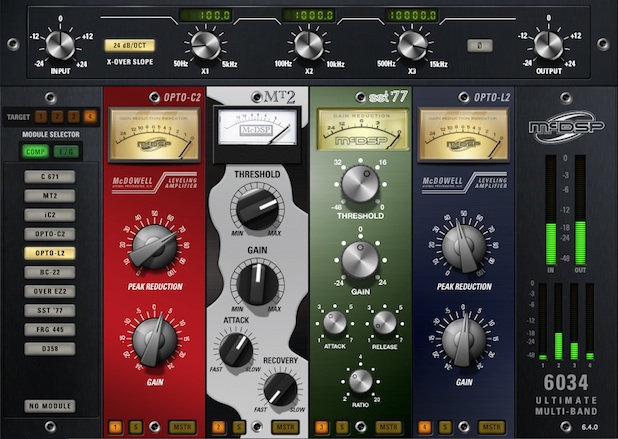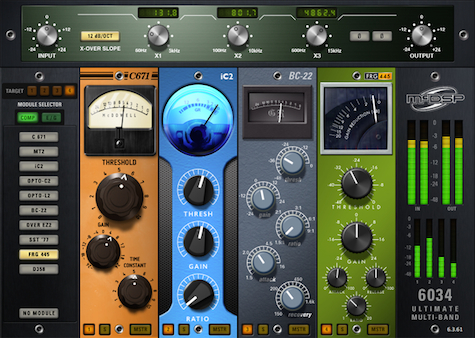New Gear Review: McDSP 6034 Ultimate Multi-band Compressor

McDSP borrows key design features from their 6030 and 6050 models to create an ultra-flexible multi-band compression solution in the new 6034 Ultimate Multi-band compressor.
When I began my first forays into engineering and mixing, I recall trying to wrap my head around the different types and aspects of compression. Attack, release, knees—how did it all come together?
With all of that rattling around in my mind, when someone first mentioned the concept of multi-band compression, I just filed it away in the “never gonna get there” section of my brain; it seemed as unfathomable to me as advanced calculus.
Fast forward to a few years later and I was struggling with a particularly difficult mix. All the instruments were recorded live and without much separation, so I was pulling my hair out trying to gain some sense of control.
A friend suggested using some multi-band compression to help solve some of the problems I was having. Being slightly more advanced by then, I opened up an instance of the McDSP MC2000 and starting tooling around. All of a sudden, I fell in love. The concepts and approach all fell into place, and I started to feel something: Ultimate control and power over the mix. I felt like I could do anything.
If you’re new to multi-band compression, the basics are simple enough. You select any range of frequencies in the EQ spectrum and set a compression ratio, along with attack and release, for that band. Typically, a multiband compressor will separate the spectrum into 4 bands (although not always) and will usually provide the option to control the overall gain for each band as well.
With this kind of flexibility, you can dynamically attenuate the low end. You can shave off only the transients in the high end, and so on, all in a way that is simply not possible with traditional EQ or compression alone.
Now celebrating their 20th year in business, McDSP has added yet another multiband compressor plugin to their huge and growing lineup: The 6034 Ultimate Multi-band compressor. Borrowing key features from some other plugins in the McDSP line, the 6034 aims to deliver power, character, and flexibility via its unique modular structure.
Features
Expanding upon some of the concepts that already exist within McDSP’s 6030 Ultimate Compressor and 6050 Ultimate Channel Strip, the 6034’s modular design offers a new take on multi-band compression. If that sounds scary, have no fear, because it is laid out in a very simple and understandable way. The Ultimate series from McDSP basically lets you swap out modules based on classic and hugely popular compressor designs to instantly alter the tone and response of the compressor.
The 6034 takes this idea one step further, allowing you to mix and match, using separate modules for each band, with each module having certain stylistic qualities. You can even swap out any one of the 10 compressor modules in real time.
Some of the modules available here are emulations of timeless classics, while other modules are based on overall design principles, such as “all tube” or “solid state”, while some are simply style-based, such as “aggressive”, “overly-aggressive”, “smooth”, and so on. Want a Fairchild 670 on the lows and highs and a Teletronix LA-2A on the midrange? Well, now you can have it.
The 6034 features Solo and Mute controls for each band, allowing you to focus on acute details in isolation, or to mute and say “Hey, let’s just make this a three-band compressor, shall we?” Also offered are a few expanders (compression’s oft-forgotten cousin) and a gate.
Another, function is the ability to control the crossover slope between the bands. As with auditioning the various compressors, you can switch between a 24, 12, and 6dB slope across the entire plugin. (A nice addition here from McDSP would be individual slope controls for each crossover point, and a graphical representation of the crossovers to help guide these choices.)
What makes the 6034 so powerful when compared with other compressors is the ability to stylize each band so extensively. Want some aggressive bass with a smooth top end? Coming right up. Washy mids with hyped lows and highs? Will that be all, sir?
But what may be the strongest aspect of this plugin is the ability to swap and audition all of the different modules in real time. For each band, you can cycle through all the available compression options and zero in on which one gives your track the character you desire.
In Use
I tried the 6034 on nearly everything I could think of during my tests. I found that, although it could be of use on essentially any source, there were a few elements on which I found it to perform brilliantly.
Drum overheads, for example, took very well to the 6034 when trying to tame some harshness in the 2-5k range. In an effort to control this area while also maintaining some of the very high end shimmer, the strength of this plugin came through with flying colors.
Not only was the frequency-dependent compression of great use here, but again, the choice of module ensured the stylistic aspect was also on point. When auditioning all of different models on each band, it was so much easier to hear which one was best to smooth out the harshness, and which one was best to accentuate the top end sheen.
The other source that I found the 6034 to excel on was my master bus. I subscribe to the philosophy of mixing into your mix bus processors—that way you’re mixing to a more accurate depiction of your end results. Before I decided on my default master bus settings, I experimented with an already-completed mix for reference. I found the 6034 to be even more effective than my SSL compressor for “gluing together” the mix.

The 6034’s unique modular design allows you to apply various flavors of compression to each individual band, further expanding upon the tonal capabilities of this distinctive tool.
In addition to all the features listed above (modular flexibility, different tone colorations), I found that the slope settings affected the overall mix in a more profound manner than just the individual tracks. Here, the tone of the 6034 shifted the mix from a distinctive, separated sound at high slopes to a more cohesive and gelled mix at lower slopes.
My approach here was pretty standard conceptually, attempting to keep the lows tight, the highs soaring but not harsh, and the low mids clear and without mud. Of course, each mix has its own unique set of demands, but I am incredibly impressed with how much vibe this thing can impart across an entire mix—though again, I do wish that each band had its own slope control.
To Be Critical
Despite all the areas where the 6034 shines, I do have some critiques. A mere instance of the plugin, with no compression happening, colors the sound. Perhaps this makes sense due to the inherent coloration that occurs when you design something to sound, for example, “all-tube”, but I found it difficult to establish a baseline to work from initially. There’s always the bypass switch, but it is tedious to have to mouse around the GUI to click it when trying to dial in sounds. Perhaps the addition of an “analog” switch, as seen on many other modeling plugins, would be of help in this regard.
The other thing that I find a little difficult to navigate are the presets. The choices available, along with their unique titles, are a bit misleading. For example, there’s a vocal preset called “Frog In The Throat”. It’s not immediately clear to me what that means. Is it for helping to create a frog in the throat or get rid of one? The results did not make it immediately apparent. There’s also about six presets for horns (in the “other” category), but only one for piano/keys. Although not a deal breaker, a more complete and easier-to-comprehend set of presets would save valuable time in the long run.
Summing it Up
Right out of the gate, the concept of the 6034 is incredibly appealing. It’s not just about the significant amount of control it offers, it’s also about capturing the right vibe and just making something feel right. When presented with this plugin, I was astounded that it was nearly the only one of its kind though (the Slate Virtual Mix Rack comes close). The idea is so simple, so obvious, it makes you say “How has this not been around forever?”
In the end, this plugin offers a downright fun take on the concept of multi-band compression. Priced accessibly at $129, the 6034 can be of great use to hobbyists and budding engineers, but make no mistake that this is a professional-grade tool. For all of us who like to play around with sound and all its possibilities, you can get stuck tinkering with the 6034 for hours. Its expansive flexibility and broad color palette have made it an almost necessary plugin for me, and now that I’ve got it, I could barely imagine how I ever survived without it.
Please note: When you buy products through links on this page, we may earn an affiliate commission.







[…] When I began my first forays into engineering and mixing, I recall trying to wrap my head around the different types and aspects of compression. Read more… […]